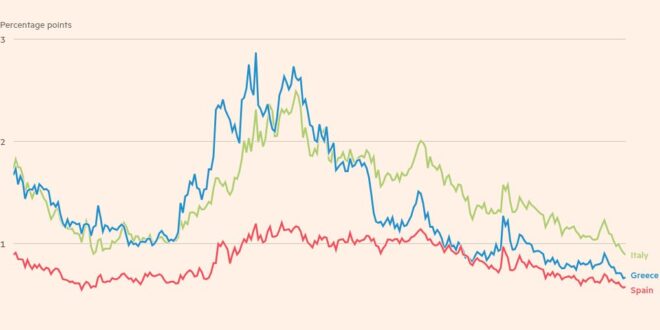Get free updates to stay informed
Just sign up. Sovereign bonds MyFT Digest – delivered straight to your mailbox
Italian, Spanish, and Greek sovereign bonds emerged as the unexpected winners of this year’s bond markets ructions. Mounting a “relentless rally”, they have narrowed Germany’s benchmark lending costs to the smallest gap in over a decade.
Bond fund managers claim that the Eurozone’s debt crisis has been resolved, despite the high borrowing costs. This is due to a stronger growth than expected and the increased sharing of the burden by all the member countries.
Italy is now paying only 0.9 percentage point more than Germany for 10-year borrowing, the lowest spread since a decade-and-a-half. Spain, the second largest economy in the eurozone, is borrowing for less than France. The spread is less than 0.6 percent.
A rise in German bond yields, as investors anticipate Chancellor Friedrich Merz’s historic €1tn spending splurge on defence and infrastructure, have also helped to push down spreads.
In contrast, during Eurozone’s crisis, the spreads of so-called peripheral countries grew due to concerns about unsustainable debts as well as the potential break-up or the currency bloc.
Credit spreads are primarily used to protect the credit market. [to reflect the risk of] Default or dissolution. If anything, this has decreased,” said Nicola Mai a sovereign credit analysts at Pimco. He said that he expected the convergence of sovereign bond yields to “last”.
In Greece, where the debt crisis sparked the regional financial crisis and led to several sovereign bailouts of the country, spreads are down to just 0.7 percentage points.
Fraser Lundie is the global head of Fixed Income at Aviva Investors.
Investors have piled up on southern European bonds, despite concerns in the global markets over heavy borrowing by governments that has pushed yields higher in large economies such as the US, UK and France.
Tighter spreads are also a reflection of a long-term strengthening for southern Europe’s public finances. Services-dependent economies flourish, helped by the post-Covid boom in tourism.
Spain’s growth was faster than that of its Eurozone peers in the past year. Giorgia Mello’s Italian government has shown to be more fiscally prudent and stable than expected by investors. Greece has been recovering from its debt crisis for years, and in 2023 it will be able to enjoy a credit rating that is investment grade.
Investors say that the fact that common EU bonds were issued during the pandemic as well as the potential of further integration have supported the argument for a convergence in borrowing costs.
Some EU leaders have argued that a common debt would help finance the pledges for defence spending, and, in the view of the market, this would bind nations together even more. However, other nations are opposed to such a move.
Fund managers say that a shift in yields higher since the Covid-era stimuli has also attracted buyers of southern European government debts. This is happening as Donald Trump’s unpredictable policies have caused investors to be wary about US markets.
Higher bond yields are attracting new demand [for bonds in the Eurozone periphery] . . . particularly when US Treasuries, German Bunds and UK gilts are proving volatile with concerns around growing supply in ‘core’ bond markets,” said Nick Hayes, head of fixed income allocation at Axa Investment Managers.
Some investors warn that the high levels of debt in southern Europe could lead to renewed concerns over bonds issued by these countries. In Italy, Greece, and Spain the debt to GDP is close to or exceeds 100 percent.
Gordon Shannon is a fund manager with TwentyFour Asset Management. He said that investors are “missing out on the wood for trees” when they think the best way to deal with the growing focus on fiscal fragility in Europe is by investing in the countries most indebted.
Barney Jopson contributed to this report. Visualisations by Ray Douglas
 Costa News Spain Breaking News | English News in Spain.
Costa News Spain Breaking News | English News in Spain.






